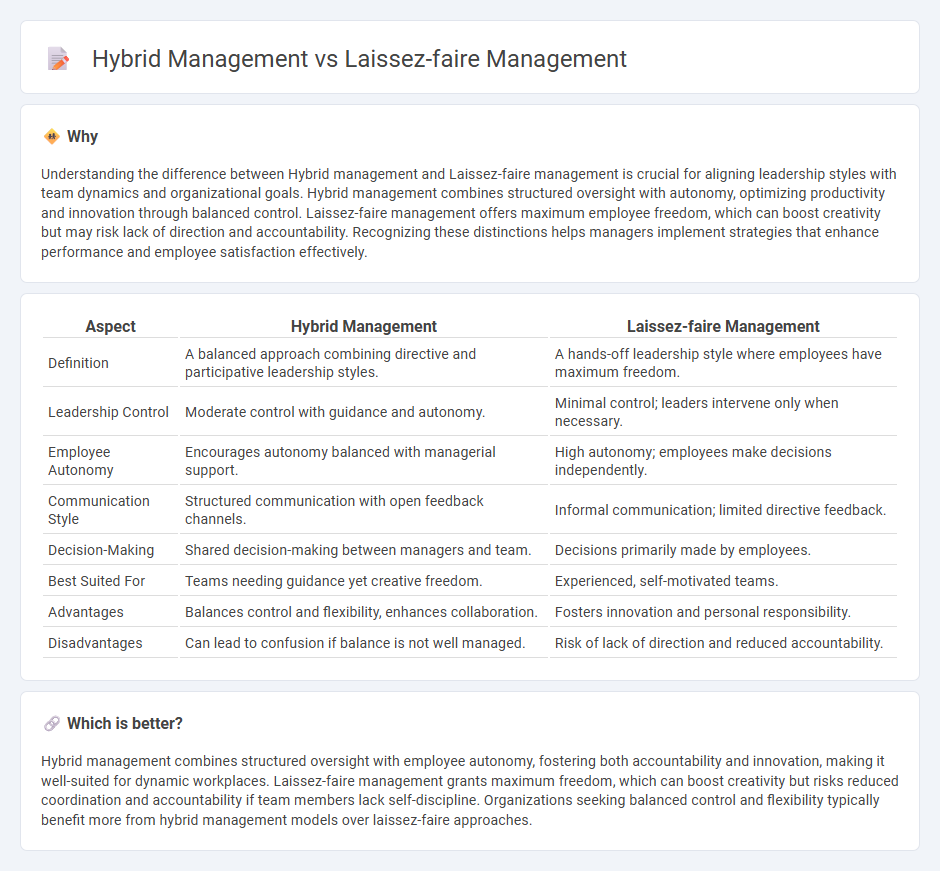
Hybrid management combines structured oversight with employee autonomy to balance control and flexibility, enhancing productivity and innovation in dynamic work environments. In contrast, laissez-faire management grants employees maximum freedom to make decisions, fostering creativity but risking inconsistent performance and lack of direction. Explore the key differences and benefits of hybrid and laissez-faire management to determine the best fit for your organization.
Why it is important
Understanding the difference between Hybrid management and Laissez-faire management is crucial for aligning leadership styles with team dynamics and organizational goals. Hybrid management combines structured oversight with autonomy, optimizing productivity and innovation through balanced control. Laissez-faire management offers maximum employee freedom, which can boost creativity but may risk lack of direction and accountability. Recognizing these distinctions helps managers implement strategies that enhance performance and employee satisfaction effectively.
Comparison Table
| Aspect | Hybrid Management | Laissez-faire Management |
|---|---|---|
| Definition | A balanced approach combining directive and participative leadership styles. | A hands-off leadership style where employees have maximum freedom. |
| Leadership Control | Moderate control with guidance and autonomy. | Minimal control; leaders intervene only when necessary. |
| Employee Autonomy | Encourages autonomy balanced with managerial support. | High autonomy; employees make decisions independently. |
| Communication Style | Structured communication with open feedback channels. | Informal communication; limited directive feedback. |
| Decision-Making | Shared decision-making between managers and team. | Decisions primarily made by employees. |
| Best Suited For | Teams needing guidance yet creative freedom. | Experienced, self-motivated teams. |
| Advantages | Balances control and flexibility, enhances collaboration. | Fosters innovation and personal responsibility. |
| Disadvantages | Can lead to confusion if balance is not well managed. | Risk of lack of direction and reduced accountability. |
Which is better?
Hybrid management combines structured oversight with employee autonomy, fostering both accountability and innovation, making it well-suited for dynamic workplaces. Laissez-faire management grants maximum freedom, which can boost creativity but risks reduced coordination and accountability if team members lack self-discipline. Organizations seeking balanced control and flexibility typically benefit more from hybrid management models over laissez-faire approaches.
Connection
Hybrid management integrates the hands-off approach of laissez-faire management with structured oversight, enabling flexibility and autonomy within teams. This blend optimizes employee creativity by allowing freedom while maintaining strategic guidance and accountability. Research shows organizations adopting hybrid management experience higher innovation and improved employee satisfaction compared to purely laissez-faire models.
Key Terms
Autonomy
Laissez-faire management emphasizes high employee autonomy, granting team members freedom to make decisions with minimal supervision, which can boost creativity and innovation. Hybrid management balances autonomy with structured guidance, allowing flexibility while maintaining alignment with organizational goals to enhance productivity. Explore in-depth comparisons to determine the best management style for your business needs.
Control
Laissez-faire management emphasizes minimal control, granting employees autonomy to make decisions and manage their tasks independently, fostering creativity and self-motivation. Hybrid management balances control by integrating both hands-off and hands-on approaches, allowing leaders to intervene when necessary while encouraging employee initiative. Discover how these management styles impact organizational control and productivity.
Flexibility
Laissez-faire management offers employees high autonomy, fostering innovation and self-motivation through minimal supervision, while hybrid management balances flexibility with structured guidance to optimize team productivity and adaptability. Hybrid models incorporate elements of remote and on-site work, enhancing work-life balance and responsiveness to changing business needs. Explore more about how these management styles impact organizational flexibility and performance.
Source and External Links
Understanding Laissez-Faire Leadership - This article describes laissez-faire leadership as a hands-off approach where leaders provide minimal oversight, allowing employees significant autonomy in decision-making and task management.
What Is Laissez-Faire Leadership? - It provides tips for implementing laissez-faire leadership by observing performance, addressing problems, and incentivizing employees to take ownership of their work.
What Is Laissez-Faire Leadership? - This page outlines the characteristics and advantages of laissez-faire leadership, including effective delegation, employee autonomy, and a creative work environment.
 dowidth.com
dowidth.com